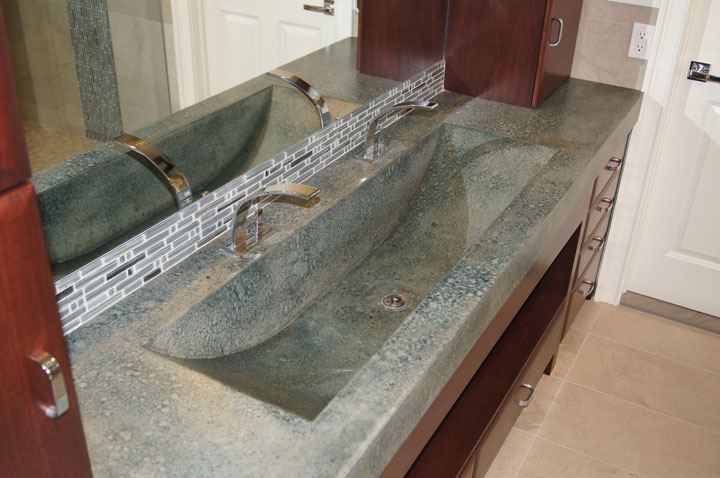Bathroom countertops must be strong enough to withstand various hazards and maintain their original appearance and qualities. They should also feature classy, cosmetic colors and artistic design patterns to enhance their aesthetic appeal. In order to satisfy all these conditions, you must be very careful and perceptive before buying any materials for your bathroom countertops. There are several types of materials that are highly regarded for bathroom countertops — all the major options are discussed and compared below.
Granite vs. Other Natural Stone
Although natural stones like granite and marble are still considered high-end materials, their prices have dropped significantly over the years. Available in many different shades and finishes including polished, satin and honed, granite now comes in many grades that are quite affordable even for a standard bathroom remodeling budget. Although granite is susceptible to grease staining unless it’s properly sealed, it’s more stain-resistant than the softer and more porous marble, limestone, and soapstone.
Natural Stone vs. Engineered Stone
Engineered stone countertops are maintenance-free and more durable as compared to natural stone vanity tops. They are also available in many colors and finishes natural stone creations. Like the other natural stone options, engineered materials cost the same as granite countertops.
Solid Surface vs. Composite Marble
Solid surface materials like quartzite are popular vanity-top choices. The easy to clean and dry material, is stain resistant, seamless, durable, and is available in many colors and shades. However, unlike natural or engineered stone, solid surface can’t stand heat or wear. Originally, composite marble was made from marble and polyester resin. Nowadays, it looks like solid surface but lacks in durability — it is recommended for tight budget remodels.
Concrete
Concrete is a favorite material for creating full customizable bathroom countertops. The highly economical material allows you to embellish your vanity top and sinks by shaping decorative edges in any desired way, and adding creative inlays and colored pigments. On the downside, concrete is easily discolored and you are advised to seal and wax your countertop with paste 2-4 times per year and every 2-3 months respectively. Many plumbing companies recommend solid surface and concrete as suitable countertop materials. Consult any company in your area that provides such services for advice. For instance, any professional company in Washington DC that offers bathroom remodeling and DC sewer services will b e able to assist you properly with a bathroom remodel if you live in this locality.
Other Materials
Other viable materials include: laminate, tiles, tempered glass, and wood.
Laminate is a vanity top material that is offered in a variety of finishes including granite and solid surface lookalikes. It is cheap, versatile, water-resistant, and stain-proof; but is vulnerable to heat and wear.
Tile surfaces are available in a vast range of finishes (natural stone) and colors (ceramics) — they can be artistically installed to create breathtaking patterns. However, tiles are high maintenance surfaces because they trap a lot of sludge in their grout borders.
Although it fits well in contemporary bathrooms, the edges of tempered glass countertops must be thoroughly polished — even then, it’s not recommended for kids’ bathrooms.
Finally, wood surface countertops are a recommendable choice, especially if you wish to project a cozy, attractive and organic design theme. However, wood is porous and must be properly sealed to prevent rot caused by water seepage.
http://plumberindc.com/5-insightful-comparisons-of-materials-for-bathroom-countertops/
No comments:
Post a Comment